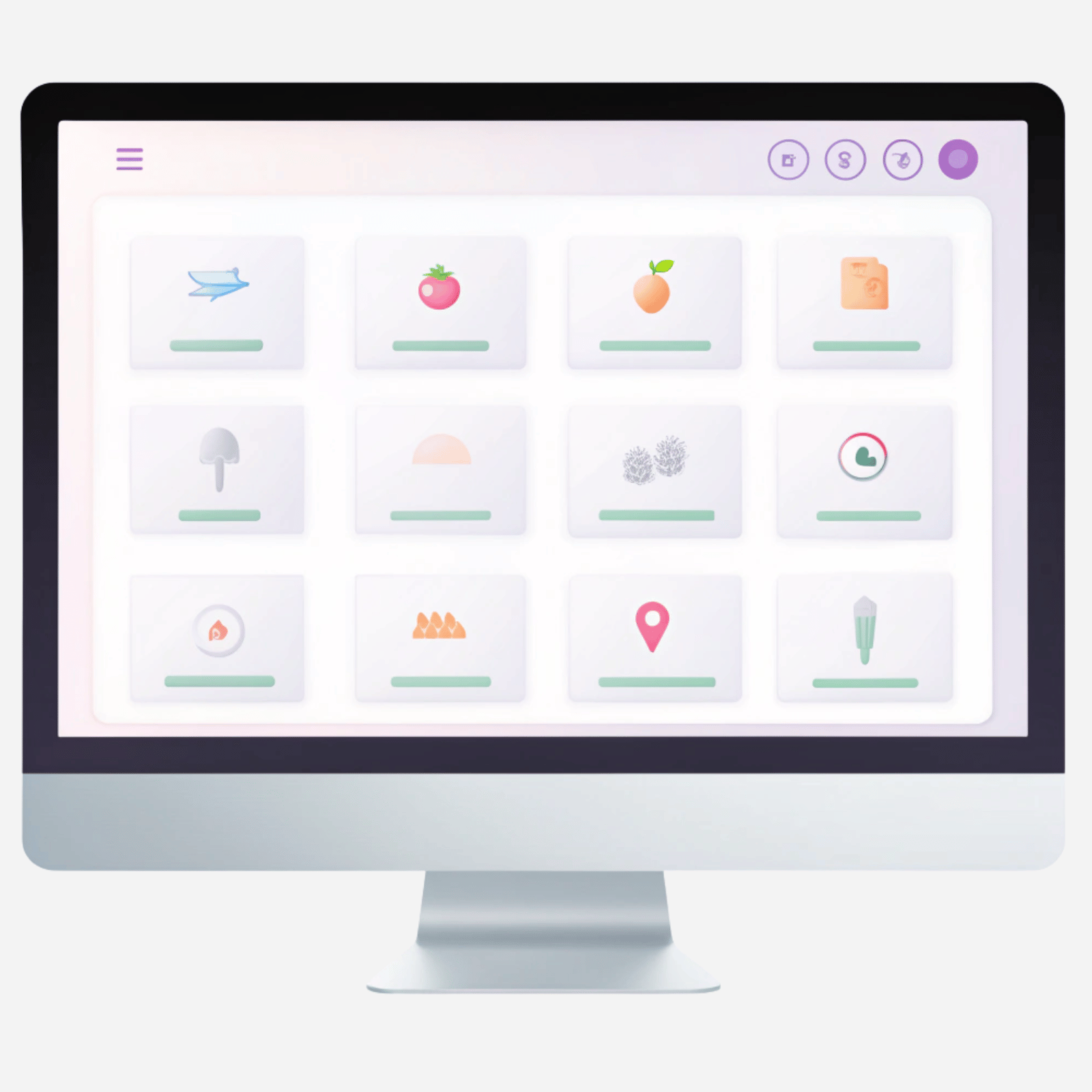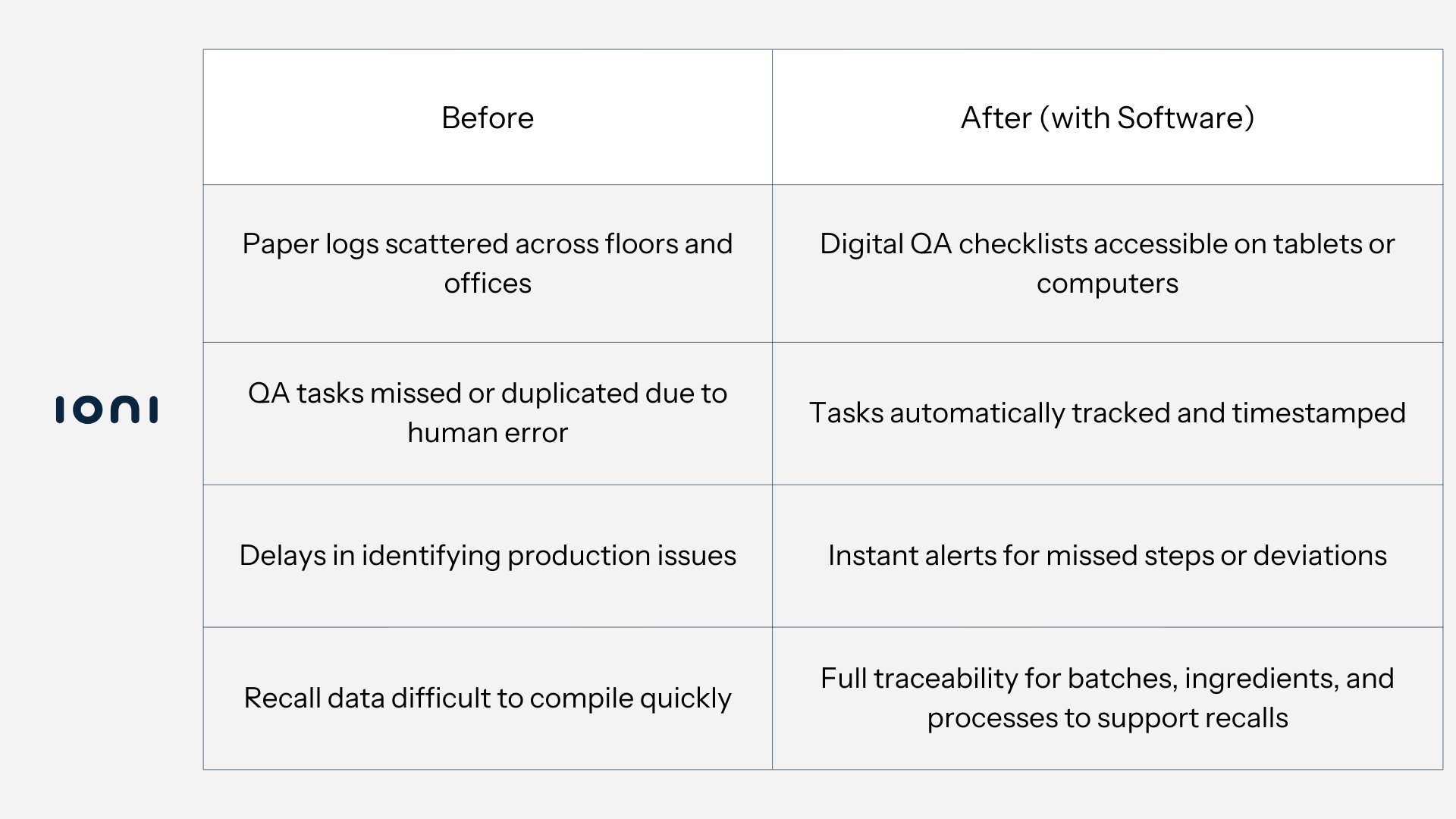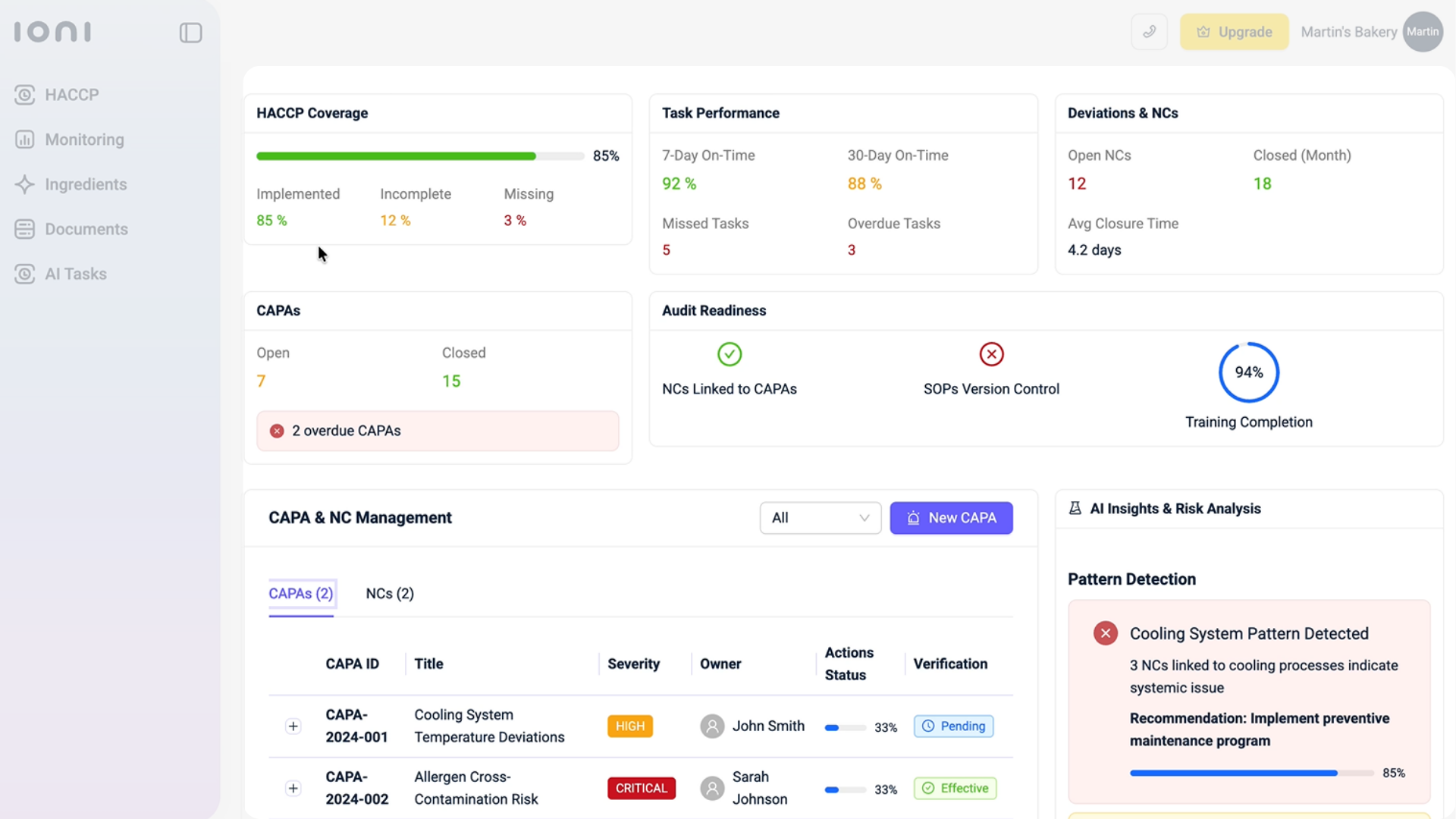
Introduction: Why Small Manufacturers are Going Digital
Small food manufacturers face persistent operational pressures that often escalate before anyone notices. In facilities with 10–50 employees, owners, general managers, and quality managers spend considerable time addressing challenges created by paper-based processes. Manual logs and checklists create bottlenecks, reduce floor visibility, and delay corrective actions. Onboarding new hires is slow, and audit preparation disrupts daily operations.
Food manufacturing software for small businesses addresses these inefficiencies by providing real-time visibility across production floors. Digitizing manufacturing allows managers to monitor operations remotely, track quality assurance activities, and identify deviations early. Facilities that implement food production management software report measurable reductions in production errors and improved compliance with HACCP, FDA, and other standards.
The adoption of digital tools is a practical response to ongoing operational challenges, high audit pressure, and competitive market demands. The digital transformation in the manufacturing industry enables small manufacturers to maintain compliance while improving efficiency.
Digitalizing the Floor: From Clipboards to Mobile Workflows
The introduction highlighted how paper-based processes create bottlenecks, reduce visibility, and increase audit pressure for small food manufacturers. Replacing manual logs with real-time digital systems gives managers full oversight of operations, enforces quality standards, and ensures issues are addressed immediately.
Small food manufacturers often rely on clipboards, paper logs, and spreadsheets to manage daily operations. These systems create delays, reduce visibility, and make it difficult to track deviations in real time. Digitizing manufacturing replaces manual processes with software solutions that centralize operations, automate tasks, and provide actionable insights.
Key Benefits of Floor Digitalization
- Real-time tracking of operations: Managers and QA staff can monitor tasks, inspections, and production workflows as they happen.
- Error reduction: Automated logging reduces missed checks, misread entries, and delayed reporting.
- Audit readiness: Digital records are timestamped, organized, and immediately accessible for inspections.
- Standardized workflows: Ensures that SOPs are followed consistently across shifts and teams.
- Food recall management: Traceability improves dramatically, allowing facilities to identify affected batches quickly, isolate products, and reduce the impact of recalls.
Workflows That Benefit Most from Digitalization
- Pre-op inspections: Digitally assign and track daily equipment and area checks.
- Batch tracking: Record production steps, ingredients, and QA checks without paper delays.
- Inventory updates: Update raw materials and finished goods in real time for better visibility.
- Recall preparation: Track every batch and its distribution, so potential recalls can be managed efficiently and safely.
How Software Enables Efficiency
- Task assignment and completion tracking: Food production management software streamlines accountability across the floor.
- Centralized dashboards: Managers can see bottlenecks, missed checks, overall performance, and traceability data at a glance.
- Automated alerts and reminders: Reduce reliance on constant supervision and ensure critical steps are never skipped.
SaaS Advantages for Small Manufacturers
- No heavy IT infrastructure is required; software is cloud-based.
- Quick setup and onboarding allow immediate visibility and control.
- Supports digitizing food manufacturing without disrupting daily operations.
Digitizing workflows strengthens compliance and operational clarity while enabling small manufacturers to handle food recalls more effectively.
Digital Checklists: Replacing Paper With Structured, Real-Time Data
Paper-based QA checklists are a common source of errors in small food manufacturing facilities. Manual logs can be misread, misplaced, or completed incorrectly, resulting in gaps in compliance and an increased risk of quality issues.
Digitizing food manufacturing processes with food production management software provides structured, real-time checklists that standardize tasks, improve accountability, and enhance traceability for food recall management.
Before vs. After Digital Checklists

Software-Driven QA Workflows
- Automated Pre-op Inspections: The software schedules, assigns, and validates inspection tasks. Alerts notify managers of missed or incomplete checks.
- Critical Control Point Monitoring: Checks like temperatures or pH are entered into the system with automated verification. Out-of-spec values trigger instant alerts and corrective action workflows.
- Batch Tracking and QA Testing: Each checklist entry is tied to a batch ID, providing complete traceability for both production and recall investigations.
- Data Validation and Reporting: The platform enforces required fields and prevents submission of incomplete forms. All entries are timestamped and stored centrally for audits.
Data Analysis and Recall Support
- Dashboards consolidate QA data to highlight recurring deviations or high-risk areas.
- The software allows managers to generate reports instantly, reducing audit prep time.
- If a product recall occurs, the system identifies affected batches and their locations in minutes, reducing response time and risk.
Implementing digital checklists allows small manufacturers to maintain compliance, reduce QA errors, and improve operational transparency.
Enhancing Productivity and Floor Efficiency Through Digital Tools
In the previous section, we demonstrated how digital checklists improve QA oversight, enforce compliance, and enable fast, accurate recall management. Building on that foundation, small food manufacturers can extend these benefits to overall production workflows.
Food manufacturing software for small businesses standardizes quality processes and streamlines operations, reduces errors, and increases floor efficiency. Digitizing manufacturing ensures that both compliance and productivity are managed within a single, integrated system.
Key Software Features Driving Productivity
- Task Management: Assign and track production and QA tasks in real time, ensuring nothing is overlooked.
- Automated Alerts: Immediate notifications for missed steps, out-of-spec readings, or bottlenecks.
- Centralized Dashboards: A Comprehensive view of the floor allows managers to monitor performance, identify inefficiencies, and act quickly.
- Batch-Level Tracking: Each production step is linked to specific batches, enabling precise tracking of output and quality.
Impact on Floor Efficiency
- Error Rate Reduction: Automated verification of tasks and data entry minimizes human error.
- Faster Response: Managers receive instant insight into workflow disruptions and can address them immediately.
- Resource Optimization: Staff time is better allocated as repetitive tasks are automated and data is centralized.
- Accountability and Visibility: Digital tracking ensures that responsibilities are clearly defined and performance is measurable.
Supporting QA and Recall Management
- Integrating digital QA checklists with production workflows strengthens overall process control.
- Automated data collection links every task to production batches and ingredients.
- Faster identification of deviations reduces downtime and improves recall response times.
Digitizing manufacturing with food production management software creates measurable improvements in productivity, floor efficiency, and compliance readiness. The software ensures that small facilities maintain high standards while minimizing errors, wasted time, and operational blind spots.
Integrating Compliance and Productivity in a Digital Manufacturing Workflow
As seen before, digital tools enhance productivity and floor efficiency. The next step is combining these gains with compliance requirements, ensuring that small manufacturers do not have to choose between speed and regulatory adherence.
Food production management software integrates compliance directly into everyday workflows, linking production, QA, and traceability in one platform.
Example: A Ready-to-Eat Sandwich Bakery
Consider a small bakery producing ready-to-eat sandwiches for regional retail. Using digital food manufacturing software, the facility manages production and compliance simultaneously:
- Batch Scheduling with QA Integration
- Managers schedule production batches in the software.
- QA checklists for each batch are automatically assigned to operators.
- Critical tasks such as ingredient verification and allergen checks are embedded in the workflow.
- Monitoring Critical Control Points (CCPs)
- Temperature readings for cooked meats or refrigeration are entered directly into the system.
- The software validates the data against pre-defined thresholds.
- Any deviation triggers an automated corrective action workflow, alerting supervisors immediately.
- Operator Accountability and Task Validation
- Operators complete tasks in real time using the software.
- Required fields prevent submission of incomplete tasks, ensuring compliance at each step.
- Digital timestamps create a verifiable record of who performed each task and when.
- Centralized Data for Compliance and Productivity
- Dashboards show production progress alongside compliance metrics.
- Bottlenecks or delayed QA checks are immediately visible, allowing managers to reallocate resources.
- Reporting is automated, combining operational data with audit-ready QA records.
- Traceability and Recall Management
- Every batch is linked to ingredient lots, QA checklists, and operator actions.
- In the event of a food safety incident, affected batches are identified instantly.
- The software generates a recall report with minimal manual effort, reducing risk and response time.
Benefits of Integrating Compliance with Production
- Efficiency: Compliance steps are embedded in daily operations, removing duplicate tasks.
- Error Reduction: Automated validation prevents missed checks or incorrect entries.
- Audit Readiness: All production and QA data is centrally stored, easily accessible, and compliant with HACCP, FDA, SQF, BRCGS, and CFIA standards.
- Enhanced Visibility: Managers monitor both productivity and compliance in one view, enabling faster decision-making.
- Rapid Recall Response: Traceability ensures quick identification of affected products, minimizing risk to consumers and brand reputation.
By embedding compliance directly into production workflows, small manufacturers can maintain high output without compromising safety or audit readiness. Digitizing manufacturing aligns operations and quality, creating a single, cohesive system that balances efficiency with regulatory adherence.
Implementing Full Paperless Modernization with IONI
As seen before, digital tools enhance productivity and floor efficiency. The next step for small food manufacturers is achieving a fully paperless operation that integrates compliance, QA, and production management into a single platform. Platforms like IONI simplify this transition, eliminating manual logs, clipboards, and spreadsheets while improving visibility, accuracy, and audit readiness.
A key advantage of IONI is fast AI-powered onboarding. Instead of spending weeks manually migrating documents and setting up workflows, IONI’s AI can analyze existing SOPs, HACCP plans, and QA documentation to automatically build structured HACCP plans, map production steps, and detect potential hazards. This accelerates adoption and reduces errors from the very first day.
Why Full Paperless Modernization Matters
- Consolidates production, QA, and compliance workflows in one system.
- Reduces errors and eliminates redundant manual tasks.
- Enables faster identification of issues and immediate corrective actions.
- Ensures audit readiness and improves traceability for food recalls.
- Rapid AI onboarding accelerates setup, minimizing downtime and operational disruption.
Detailed Step-by-Step Implementation Roadmap
Step 1: Assess Current Processes
- Conduct a floor-level audit of existing QA, HACCP, and production workflows.
- Identify all paper forms, clipboards, and manual logs in use.
- Evaluate critical processes for compliance, recalls, and productivity.
Step 2: Upload and Digitize Documents with AI
- Upload SOPs, QA checklists, HACCP plans, and supplier records into IONI.
- AI parses documents and automatically builds a structured HACCP plan.
- Maps workflows to digital templates and detects gaps or inconsistencies.
- Ensures full compliance capture and reduces manual setup errors.

Step 3: Configure HACCP and Compliance Workflows
- Set up facility information, HACCP team members, product definitions, and flow charts.
- Define critical control points, thresholds, and alerts.
- Link all documentation to production lines and batches for a single source of truth.

Step 4: Assign Roles and Train Staff
- Assign responsibilities to operators, QA staff, and managers.
- Conduct interactive training using IONI’s AI-guided onboarding.
- Staff learn to complete digital checklists, log deviations, and follow CAPA workflows efficiently.
Step 5: Enable Real-Time Monitoring and Alerts
- Activate deviation detection for production, storage, and quality metrics.
- Automate alerts for out-of-spec readings, missed steps, or CCP violations.
- Escalate high-risk deviations immediately for corrective action.
Step 6: Implement AI-Supported CAPA Management
- AI generates prioritized corrective and preventive actions.
- Corrective actions: batch quarantines, reprocessing, and equipment recalibration.
- Preventive actions: SOP updates, new monitoring points, scheduled maintenance.
- High-risk issues receive immediate attention to reduce operational risk.

Step 7: Centralize Dashboards and Reporting
- Dashboards consolidate production, QA, and compliance data.
- Monitor deviations, CAPA progress, SOP updates, certifications, and training.
- Generate audit-ready reports instantly without manual effort.

Step 8: Continuous Improvement and AI Insights
- AI analyzes historical and live data to detect recurring issues, emerging risks, or workflow inefficiencies.
- Identify weak points in HACCP controls, missing training, or outdated SOPs.
- Adjust workflows, update documentation, and train staff based on insights.
Common Pitfalls and How IONI Solves Them
- Incomplete data migration: AI automatically structures documents and workflows.
- Staff resistance: Guided AI onboarding simplifies adoption and builds confidence.
- Overcomplicated workflows: Digital tasks are directly aligned with production and QA steps.
- Manual reporting: Dashboards and automated reports remove duplicated effort.
Benefits of Full Paperless Modernization with IONI
- Efficiency: Less time on administrative tasks, more focus on production.
- Accuracy and Compliance: Automated validation reduces human error and ensures audit readiness.
- Traceability and Recall Readiness: Full visibility of batches, QA checks, and production steps enables rapid, precise recalls.
- Rapid Onboarding: AI-driven setup enables fast adoption and immediate operational oversight.
- Scalable and Cost-Effective: Small facilities can implement IONI quickly, at low cost, and scale as operations grow.
Get started with IONI today to digitize your floor, automate QA tasks, and ensure audit readiness. AI-powered onboarding gets your small facility up and running in days.
Conclusion: The Impact of a Digital, Paperless Floor
Small food manufacturers face constant pressure from regulatory requirements, floor inefficiencies, and recall risks. Moving from paper-based operations to a fully digital workflow fundamentally changes how these facilities manage compliance, QA, and production. This shift is part of the broader digital transformation in the manufacturing industry, enabling even small facilities to adopt advanced tools traditionally reserved for larger operations.
Platforms like IONI demonstrate that paperless modernization is achievable without major disruption. AI-powered onboarding enables fast setup, digitizes SOPs and HACCP plans, and structures workflows for immediate operational visibility. Digital checklists replace scattered logs, automatically track QA tasks, and link production steps to compliance standards. This level of traceability ensures rapid response to deviations and streamlines recall management, reducing risk and downtime.
Experience the full benefits of paperless modernization. Start your free trial of IONI and see how fast AI can structure your HACCP plans, automate workflows, and enhance compliance.
Integrating compliance and productivity into one system creates a single source of truth for facility operations. Managers gain real-time dashboards, automated alerts, and actionable insights that support both day-to-day efficiency and long-term strategic planning. By centralizing tasks, automating CAPA workflows, and continuously monitoring production, small facilities operate with higher accuracy and accountability, minimizing errors and audit risks.
The benefits extend beyond immediate operational improvements:
- Regulatory Confidence: Compliance with HACCP, FDA, SQF, BRCGS, and CFIA standards is continuously maintained and easily documented.
- Operational Clarity: Managers and staff see production status, QA performance, and deviations in real time.
- Traceability and Recall Readiness: Every batch and process step is linked, enabling faster, precise recall actions.
- Sustainable Efficiency: AI-driven insights identify recurring issues and suggest preventive actions, supporting continuous improvement.
- Scalability: Small facilities can adopt digital workflows quickly and expand them as the business grows.
By moving to a fully digital, paperless floor, small food manufacturers achieve a proactive, compliant, and efficient operation, where risk is minimized, accountability is enforced, and audit readiness is built into daily routines.
AI-driven platforms like IONI make this practical, cost-effective, and scalable, ensuring that even small operations can compete with larger facilities while maintaining the highest standards of food safety.









